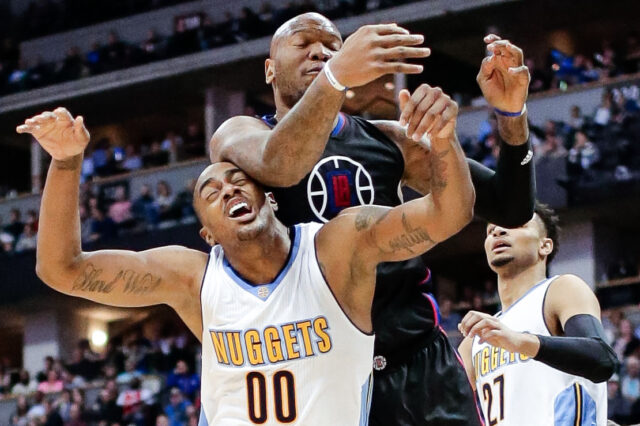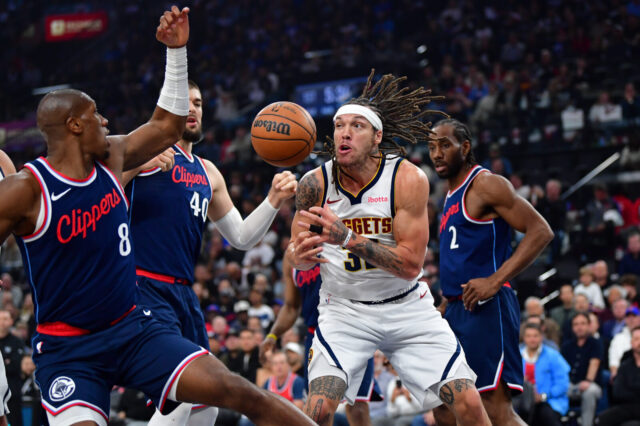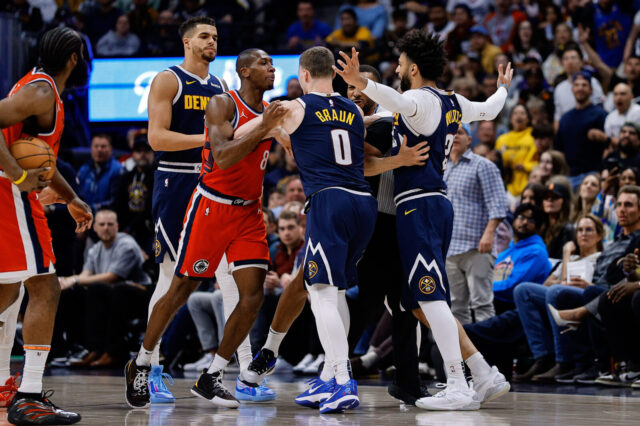Millsap’s quick post ups
Nikola Jokic can learn a lot from Paul Millsap. One thing he should absolutely steal from his game is how quickly he attacks whenever he gets a quick post entry off of a mismatch. Where Jokic tends to stop and survey the court before attacking, Millsap likes to put pressure on his defender right away, often getting them off-balance with a quick fake before attacking the outside shoulder.
Millsap is more of a scorer and Jokic more of a passer out of the low and mid post and there are advantages for passing big men when you take time to survey the court rather than attack quickly. The slow it down approach is great for luring help side defenders out of position for a kickout. It can also help limit turnovers since it allows for a bit more control. But when a smaller defender switches onto a big and the team is able to get the ball to the big man quickly, it’s usually best to attack right away.
There’s no need for a brilliant move in these situations. Often just attacking one shoulder or the other (never trying to go right into the chest of the smaller defender) is enough to force either a quick help side rotation or provides enough room for a wide-step spin move and finish. Jokic is at his best when the game speeds up since his decision making under tight windows is almost always better than everyone else.
Millsap diving to avoid the dreaded 4-5 DHO
This was the play of the game. If you recall in my last article, I talked specifically about this type of situation in a free-flowing offense. Jokic receives the ball at the top of the key and turns to run a dribble hand-off (DHO) with whoever is on the side of the floor of the reversal. When that player is Millsap, the DHO is often pointless since the defense will either switch the screen o go deep under the screen, unafraid of Millsap’s pull-up three-point shot. The best rule of thumb the Nuggets can instill is to have Millsap dive every time he finds himself in this situation.
That’s exactly what happened on the biggest and most important possession of the game against the Lakes. Jokic caught the ball at the top of the key and turned to attack the left side of the court, hunting for a DHO. Millsap was there, as was Gary Harris on the wing and Jamal Murray in the corner. Millsap quickly made the read to dive and drag his defender with him. Harris also dove (remember, in a free flowing offense, he can either dive or come off the screen) and carried his defender with him.
Those two dives made the help side rotations complicated for the Lakers and Murray was able to attack off of the DHO, toss the ball back to Jokic on the roll who then hit Millsap right under the basket. It was a bang-bang play but it was the perfect reads by all parties involved. And everyone knew it. Just look how excited both Jokic and Millsap are after the and-1 call. They’re still far from being 100% on the same page, but that possession provided a glimpse of what it can look like once they are.
Dirty Euro foul
One of Joker’s worst habits is his propensity to give the “euro foul,” a foul where you deliberately grab a player in order to stop a fast break. These fouls are common in FIBA play and in addition to being among the most annoying type of fouls (seriously, who wants to prevent fast break highlight plays?), they aren’t quite as useful in NBA play since a team can enter the bonus after just 5 team fouls.
But against the Lakers, Jokic gave a “dirty Euro foul” by committing the fast-break-preventing back court foul while the Lakers were in the bonus. So instead of stopping a fast break, he put Kentavious Caldwell-Pope on the free-throw line, a career 78% free throw shooter.
Denver has actually done this a few times lately and it’s an absolute killer.
Lonzo blueprint for Plumlee and Millsap
One of the big questions surrounding the Denver Nuggets right now is how they can properly space the floor when Jokic shares the court with another big, primarily either Millsap or Mason Plumlee. I’ve written in depth about the use of short-corner gravity and why Kenneth Faried was such a dynamic offensive pairing with Jokic and both Millsap and Plumlee have shown flashes of similar production from the short corner spot (also known as “the dunker spot” or simply “the dunker). However, neither Millsap nor Plumlee have the same quick-twitch explosiveness as Faried or the knack for drawing opponents away from the paint when working the dunker.
One alternative way for both players to involve themselves in the offense is to become heat-seeking screening missiles on the weak side when Jokic is either posting up or running DHOs on the strong side.
There is an art to this. It involves reading who is most vulnerable to a weak side screen, anticipating the perfect timing of the screen, and being quick to read and react to everything else happening on the court. In Friday’s game, Lonzo Ball provided a great example of this idea. Watch how Lonzo cuts through to the weak side but rather than simply spotting up behind the arc, he sets himself behind Murray and sets a sort of impromptu “hammer” screen (or flare screen).
Note: teams run “hammer” action which is a set play that takes advantage of this very idea. But players can execute this same concept within the flow of the offense simply by being aware of the possibility. In hammer sets, the play is usually specifically designed to get a kickout three but as you’ll see, there are other positives that come from these types of weak side screens on help defenders.
The screen itself is useful in case Brook Lopez decided to try and kick the ball out for a spot up shot. Murray would have to fight over the screen to close out and would either be late to contest the shot or would expend a little extra energy just to do his job. But the real value of this screen (and every screen) is that it makes the defense think. Every well-timed screen creates one extra calculation for everyone involved and on this play, Murray becomes focused on getting around the screen that he leaves Lonzo once the shot goes up. At the same time, Millsap – who is actually the one responsible for boxing out Lonzo – assumes that Murray has him and helps Harris box out Caldwell-Pope instead. That allows Lonzo to release the screen as the shot goes up and waltz unimpeded toward the basket for the putback.
It looks like such a simple thing but there’s a reason that as a rookie Lonzo grabs nearly 4% of all available offensive rebounds, a surprisingly high mark for a point guard. More importantly, this is exactly the type of thing Millsap and Plumlee can do whenever they tire of spotting up or playing the dunker.
As a player, I used to love this role on offense. Your focus turns from trying to find open spots on the court to trying to find the defender most vulnerable to a weak side screen. Often times, it allows you to hit a defender with a completely blind screen as they have their heads turned to watch the ball. Other times, it allows you as a screener to “take control” of the possession without getting in the way of the ball. When done right, the weak side is forced to react to the screen while trying to also react to the ball on the other side of the court. The more calculations you can force a defender to make, the better chance you have of getting them to slip up.
Jokic taking control
This three-play sequence was very encouraging for a variety of reasons. First, the Nuggets appear to have called for a specific pindown action to get Harris an open three early in the 3rd quarter but Murray sees an opening and goes off-script, attacking the basket instead. This isn’t a bad idea, just bad execution. The Nuggets are best when their offense allows for the flexibility to go off-script so Murray attacking an open lane is within the realm of acceptable decision making. What fails is that he is slow to read Lopez’s fully committed help side attack which would’ve left the Lakers scrambling had he attacked with more awareness.
But what’s most interesting about this is actually what happens next. On the next possession, Millsap appears to head for the low block to call for a post up but Jokic orders him to get out of the way. This assertiveness is new for Jokic and likely a sign that he is accepting the reigns as the head of the offense. Millsap gave Jokic as strong of an endorsement as possible earlier this week saying:
“He’s such a humble guy hat sometimes he looks for me to do things and it’s him. He’s our team. He makes a lot of things go for us so he’s got to continue to stay aggressive. I’m here to help him and back him in any way possible.”
It can’t be overstated how impressive of a quote this is from Paul Millsap, a four-time all-star and the anchor of several great teams in Atlanta. Millsap has had 50+ seasons, scored against the best defenses, and been a go-to guy for several seasons. Jokic is a pup who doesn’t have nearly the career accomplishments (or the paycheck) as Millsap. For many stars, this level of humility is unthinkable. But Millsap is 100% right. Jokic is a special offensive talent and this team is best when he is the fulcrum of it all.
So here in the 3rd quarter, Jokic orders Millsap off of the block so that the team can correctly run the play they planned on the previous trip down the court and look at the result.
Even better, the very next time down court, the Nuggets run the play for Millsap to get a post touch. And once again, look at the result.
This is what basketball is all about and this is the flash of top-down cohesiveness the Nuggets need. The team may have finally found the the ability to put their faith in Jokic and Jokic looks ready to run the show so that everyone remains involved and gets the ball in spots they are most comfortable.


